Fraxinicola fraxini (Aderh.) Crous, M. Shen & Y. Zhang ter, comb. nov.
MycoBank number: MB 831587; Index Fungorum number: IF 831587; Facesoffungi number: FoF 12062; Fig. 13.
Basionym: Venturia fraxini Aderh., Hedwigia 36: 83. 1897.
Synonyms: Fusicladium fraxini Aderh., Hedwigia 36: 74, 83. 1897. Fusicladium proteae Crous, Persoonia 27: 34. 2011. See Schubert et al. (2003) for additional synonyms.
Typus: Parasitic on leaves of Fraxinus excelsior (Oleaceae) (lectotype designated here Aderhold 1897, plate IV, fig. 6, MBT391370). Switzerland, Spiez, on leaf of F. excelsior as endophyte, 31 Aug. 2013, M. Schlegel (epitype designated here, specimen CBS 140930, MBT391371, as metabolically inactive culture, ex-epitype culture CBS 140930).
Additional materials examined: Italy, Premia, on leaf of F. ornus (Oleaceae) as endophyte, 31 Aug. 2013, M. Schlegel (culture CBS 140929 = VE 2). South Africa, Western Cape Province, Hermanus, Fernkloof Nature Reserve, on leaves of Protea sp. (Proteaceae), 5 May 2010, P.W Crous (ex-type culture of F. proteae CBS 130599 = CPC 18282). Switzerland, Monte Caslano, on leaf litter of 374. excelsior (Oleaceae), 5 2013, M. Ibrahim (culture CBS 140935 = VE 12); Kt. Wallis, Brig, on F. excelsior, 10 Jul. 1953, E. Müller (culture CBS 374.55).
Notes: Venturia fraxini, the basionym of Fraxinicola fraxini, was reported as an endophyte of Fraxinus excelsior (Aderhold 1897, Ibrahim et al. 2016). Morphologically, Fraxinicola fraxini (conidia fusoid to obclavate, 12– 28 × 4– 6(– 7) μm, (0 –)1(– 3)-septate), is comparable with Fusicladium proteae (conidia obpyriform, un- equally 1-septate, (13 –)17 – 22(– 30) × 4(– 5) μm, Schubert et al. 2003, Crous et al. 2011). Phylogenetically, the type isolate of Fusicladium proteae (CBS 130599) forms a conspecific clade together with isolates identified as Fraxinicola fraxini (Fig. 2). Thus, we assigned Fusicladium proteae to synonymy with Fraxinicola fraxini. Fusicladium proteae was reported as a causal agent on leaf spots on Protea sp. in South Africa (Crous et al. 2011). Fraxinicola fraxini is sister to F. orni / italica in Figs 1, 2.
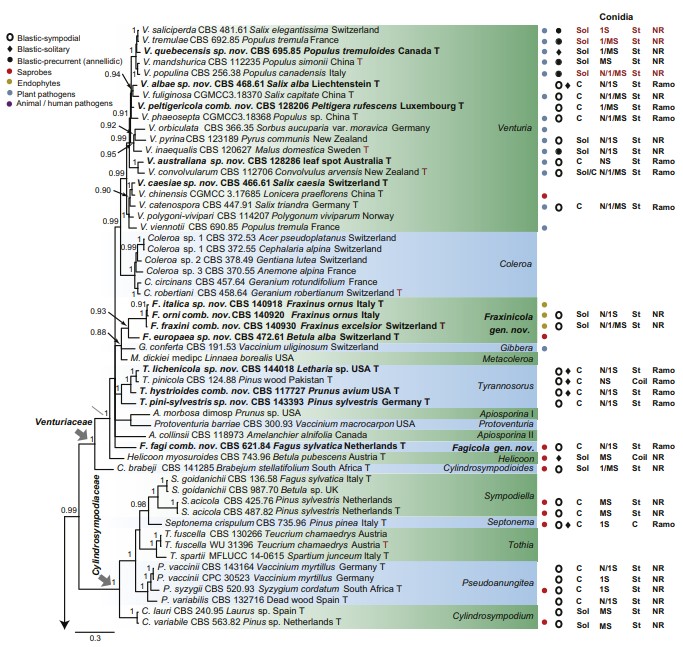
Fig 1. Consensus phylogram (50 % majority rule) of 691 952 trees resulting from a Bayesian analysis of the combined alignment of ITS, LSU, tef1, tub2 and rpb2 sequences of Venturiales. Bayesian posterior probabilities (PP) > 0.80 are shown at the nodes and the scale bar represents the expected changes per site. Some branches were shortened to facilitate layout. The tree was rooted with Microthyrium microscopicum (CBS 115976). Culture collection numbers, substrates and countries are indicated behind the species names. Those highlighted in bold are new taxa or new combinations proposed in this study, and type strains are marked with “T” (ex-type in black, ex-epitype in red). Relevant morphological characteristics plotted are abbreviated as follows: Sol – conidia solitary, C – conidia in chains, NS – aseptate conidia, 1S – 1-septate conidia, MS – multi- septate conidia (septa ≥ 2), St – straight or slightly curved conidia, Coil – coiled conidia, Y – Y-shaped conidia; Ramo – ramoconidia present, NR – ramoconidia not observed; ? – asexual morphology not available (either from references or from sporulation induced in this study); and morphological characters plotted in red means strains failed to sporulate in this study and plotted values are taken from the original description, observation of this study or related references. Other characteristics are explained in the legend.
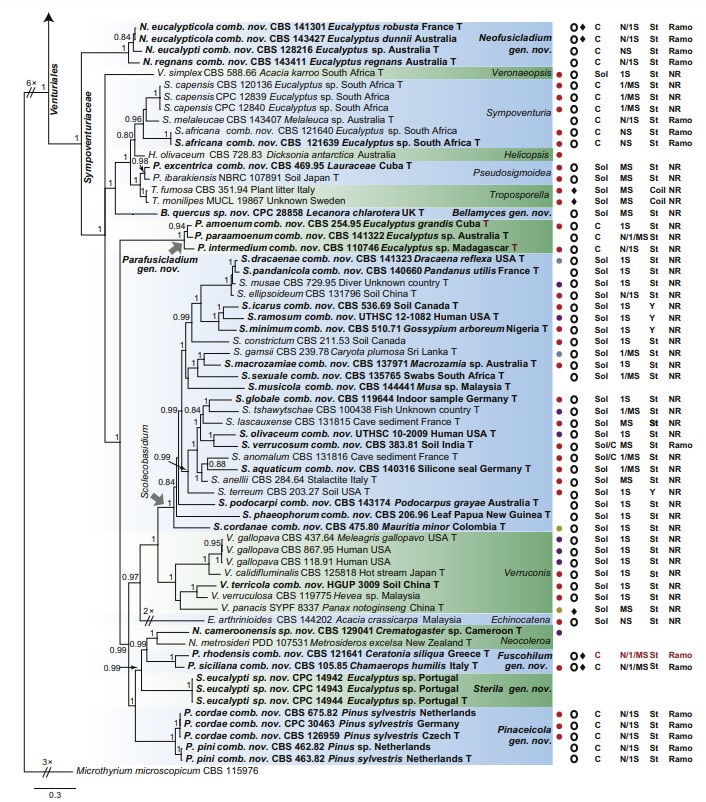
Fig 1. (Continued).
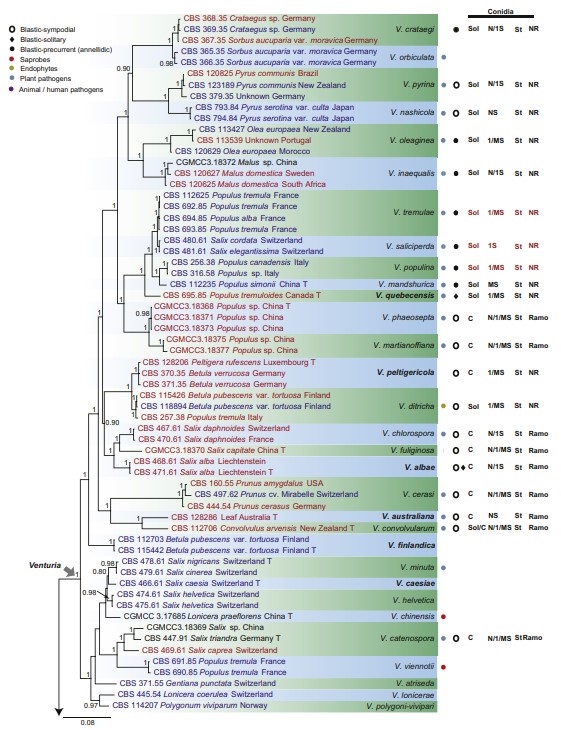
Fig 2. Consensus phylogram (50 % majority rule) of 42 902 trees resulting from a Bayesian analysis of the combined alignment of ITS, LSU, tef1, tub2 and rpb2 sequences of Venturiaceae. Bayesian posterior probabilities (PP) > 0.80 are shown at the nodes and the scale bar represents the expected changes per site. Some branches were shortened to facilitate layout. The tree was rooted with Pseudoanungitea vaccinii (CBS 143164). See title of Fig. 1 for an explanation of the characters plotted on the tree. Strains in red text sporulated in this study, while those in blue text failed to sporulate and those in black text were not studied.
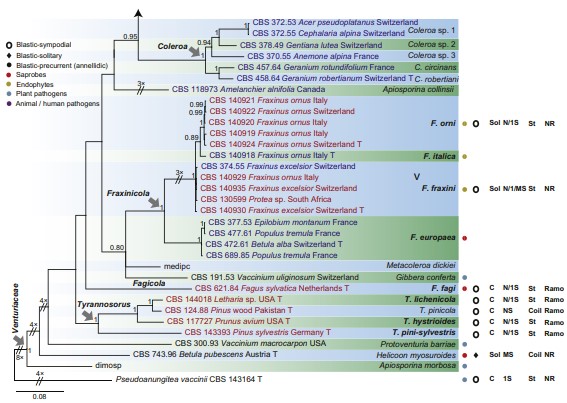
Fig 2. (Continued).
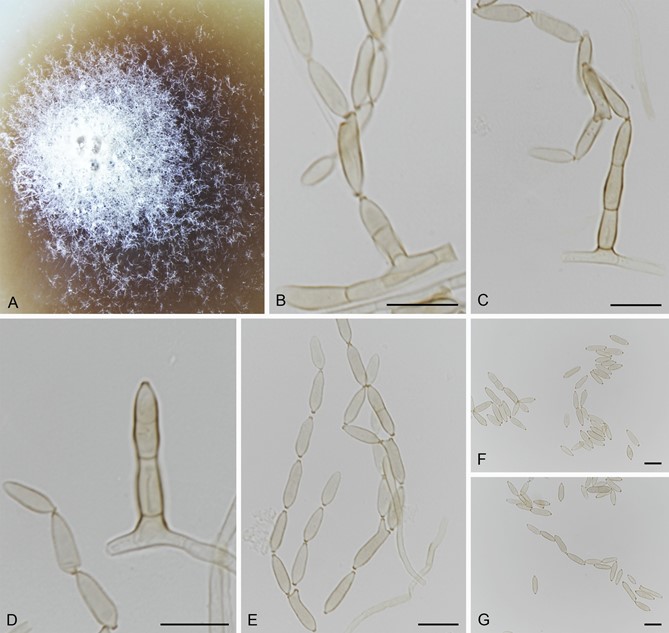
Fig. 6. Neofusicladium eucalypticola (culture ex-type CBS 141301) asexual morph. A. Colony on OA. B– E. Concatenated conidia arising from hypha. F, G. Pale brown and aseptate or 1-septate conidia. Scale bars: B–G = 10 μm.

Fig. 13. Fraxinicola fraxini (culture CBS 140930) asexual morph. A. Colony on OA. B– F. Sympodial conidiogenous cells producing conidia. G– J. Brown, 1–3-septate, tapering conidia. Scale bars: B– J = 10 μm.
